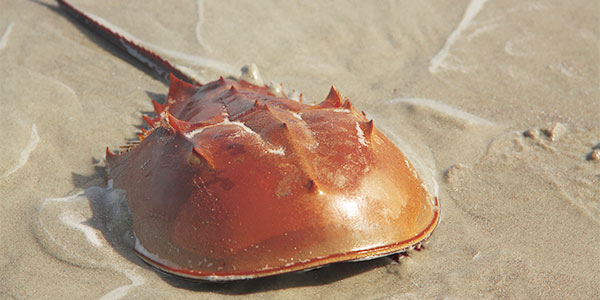The Wonder of Horseshoe Crabs

February 24, 2021
As I was walking down a South Carolina beach, I encountered a fossil looking shell with a sharp tail embedded into the sand. After a closer look, I soon realized that it was a horseshoe crab and quickly returned it back to the ocean. These horseshoe crabs often get stranded on the beach due to their mating patterns and low tides, and are unable to return until the tide brings them back in. While the appearance of the horseshoe crab may appear threatening, they are one of the most docile creatures when in contact with humans and are extremely important to the biomedical and pharmaceutical industry. Their origins date back to around 450 million years and they have remained unchanged throughout, making them very unique from a biological standpoint, and are overall very interesting creatures.
The horseshoe crab has been around for millions of years, they have passed the dinosaurs, survived five mass extinctions, and survived humans, making them a great survivor. They are able to survive so well due to their diet, biological systems, and primitive immune system. Horseshoe crabs can essentially consume any organic mature that is not poisonous to them and will be able to digest it and use the nutrients it possesses, which greatly helped them during the mass extinctions when food sources were sparse. Another interesting part of the horseshoe crab is their ability to survive on low levels of oxygen, which aids in surviving periods of low oxygen levels in the oceans. The blood inside of these primitive creatures does not contain hemoglobins found in human blood to transport oxygen but use hemocyanin, giving the blood a distinctive blue color. This also blood does not react to an immune response the typical way human’s blood does when coming into contact with bacteria (clotting with platelets), but rather clots up together to form a wall around the cut to prevent further infections, which is a surprisingly effective immune response. These three unique factors about horseshoe crabs make them amazing survivors given they have survived for millions of years and five mass extinctions.
Horseshoe crabs also contain a vital element which is incredibly important to the biomedical and pharmaceutical industries: their blood. Inside of their blood is a compound not seen anywhere else on earth and is unable to be produced synthetically, limulus amebocyte lysate (LAL). LAL is a substance that detects molecules called endotoxins, which is a bacterial toxic that can be found in pharmaceutical drugs, medical equipment, and vaccines. Endotoxins are found to be very detrimental if found in our bodies and a major concern of the medical industry to prevent these, and using LAL is one of the only and most reliable tests for them. The LAL test consists of exposing the sample being tested (a vaccine, hip replacement, drug, etc) to Horseshoe crab’s blood. If the blood clots or changed color, endotoxins are present in the sample. The rate of clot or color change increases with the amount of endotoxins in the sample. This test is crucial in the medical field and creates a large demand for horseshoe crab blood and the harvesting of the animals.
The mass farming and harvesting of horseshoe crab’s blood has negatively impacted their populations. When horseshoe crabs are harvested roughly 30% of their blood is taken then they are returned to the beaches they were found in. While this method of harvesting the sepcicies is effective in keeping the survival rates for it up, it is still detrimental to the horseshoe crab populations. In addition to the mass harvesting of these creatures, many other animals including shorebirds living along coastal beaches will dine on horseshoe crab’s eggs during their mating seasons, effectively decreasing the population of the next generations to come. Both the horseshoe crab and shorebirds, or whatever other creatures eat the horseshoe crab eggs, have majorly declined due to the harvesting of the species and without active effort for the conservation of horseshoe crabs, the species will continue to decline.
Horseshoe crabs have proven to be one of the most interesting creatures for their anatomy, age of existence on the Earth, and blood. Countless times these creatures have survived mass extinctions, harvestings, and humans but conservation of these animals need to be a top priority if we’d like to have safe vaccines, medical treatments, and drugs in the future.











